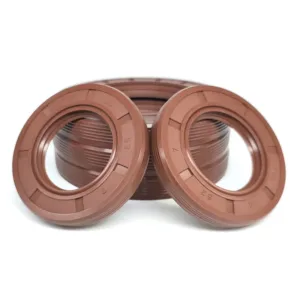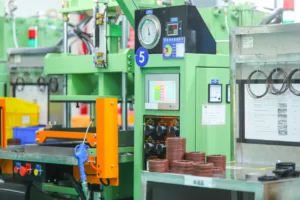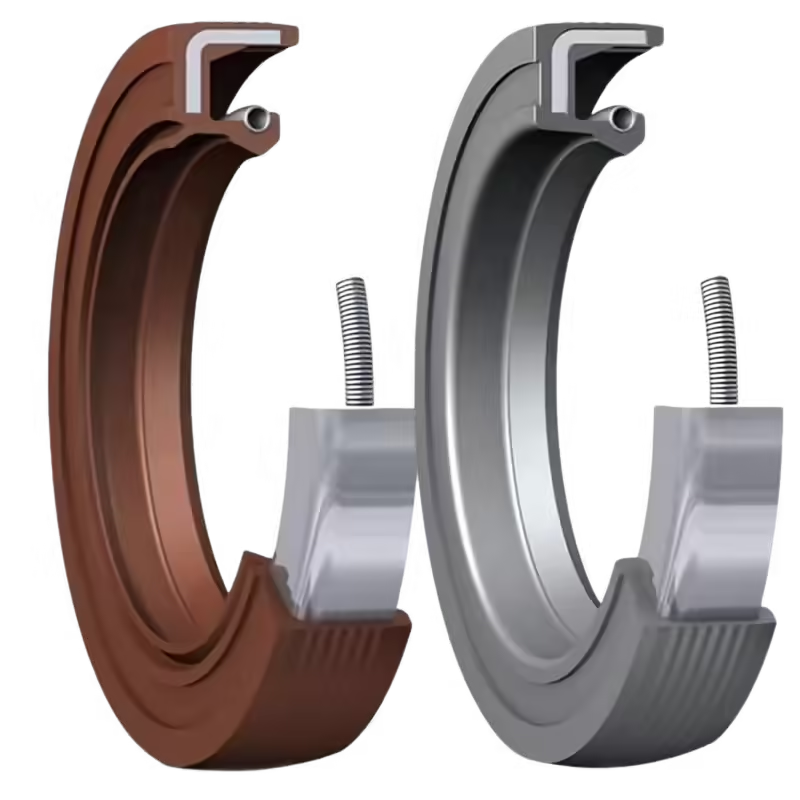How to Identify an Oil Seal
1. Introduction
Oil seals are integral components in a multitude of industries, playing a pivotal role in maintaining the efficiency and longevity of machinery. These seals prevent fluid leakage and protect critical machine parts from contaminants, ensuring smooth and uninterrupted operations. Proper identification and selection of oil seals are essential not only for seasoned professionals but also for beginners venturing into the sealing industry. However, the process of identifying the right oil seal can be intricate and daunting for newcomers due to the vast array of options and technical specifications involved.
At DRO, we recognize the challenges faced by beginners in this field. While DRO may not yet rival top-tier brands like SKF, NOK, or Parker, our commitment to learning from the best and striving for excellence propels us towards becoming a globally recognized name in the sealing industry. This article aims to demystify the process of identifying oil seals, providing a comprehensive guide for beginners to navigate the complexities of seal selection effectively.
2. Understanding the Basics of Oil Seals
Definition and Primary Function
An oil seal is a mechanical device designed to contain lubricants within machinery while preventing the ingress of contaminants such as dust, water, and other harmful substances. By maintaining the integrity of the lubricating fluid and shielding vital components, oil seals ensure the smooth operation and extended lifespan of mechanical systems.
Basic Components
Oil seals typically consist of three primary components:
- Sealing Lip: The flexible element that makes contact with the rotating shaft, creating a barrier to fluid and contaminants.
- Casing: The rigid outer shell that holds the sealing lip in place and provides structural support.
- Spring: A component that applies consistent pressure to the sealing lip, maintaining effective contact with the shaft.
Key Materials Used
The performance of an oil seal is heavily influenced by the materials from which it is made. Common materials include:
- Rubber (NBR, FKM): Known for their elasticity and resistance to oil and various chemicals.
- Metal: Provides structural strength and durability, often used in high-pressure applications.
- Polyurethane and Silicone: Offer specialized properties such as enhanced flexibility and resistance to extreme temperatures.
Importance of Choosing the Right Oil Seal
Selecting the appropriate oil seal for a specific application is crucial. The right seal ensures optimal performance, minimizes maintenance costs, and prevents machinery failures. Factors such as operating environment, fluid type, and mechanical stress must be carefully considered to make an informed selection.
3. Why Identifying an Oil Seal is Challenging for Beginners
Complexity of Oil Seal Identification
For those new to the sealing industry, distinguishing between various oil seals can be perplexing. Differences in material composition, design intricacies, and functional applications add layers of complexity. Beginners must grasp the fundamental aspects of oil seals to make accurate identifications and selections.
The Role of Manufacturers
Established manufacturers like SKF, NOK, Parker, Freudenberg, Trelleborg, and Garlock have set high standards in the oil seal market. These companies are renowned for their rigorous quality control and the longevity of their products. Their seals often adhere to stringent industry standards, making them more reliable. However, for beginners, navigating the extensive product lines and understanding the specific features of each brand’s offerings requires considerable knowledge and experience.
The Need for Training
Technical expertise is indispensable in the sealing industry. Professionals often undergo specialized training to comprehend the nuances of different seals, including their materials, designs, and performance characteristics. This expertise enables accurate identification and selection, highlighting the importance of comprehensive training for those entering the field.
4. Key Features to Look For When Identifying an Oil Seal
1. Size and Dimensions
Accurate measurement of the oil seal’s inner diameter (ID), outer diameter (OD), and width is fundamental. Precision in sizing ensures a perfect fit, preventing leaks and ensuring effective sealing. Tools such as calipers or micrometers are typically used to obtain these measurements accurately.
2. Material Type and Hardness
The material of an oil seal determines its durability and resistance to environmental factors such as temperature, chemicals, and pressure. Common materials include:
- Nitrile Rubber (NBR): Offers good oil resistance and is suitable for moderate temperatures.
- Viton (FKM): Provides excellent resistance to high temperatures and aggressive chemicals.
- EPDM: Ideal for applications involving water and steam. Understanding the material properties is crucial for selecting a seal that can withstand the specific demands of an application.
3. Seal Lip Design
The design of the sealing lip significantly impacts the performance of an oil seal. Key variations include:
- Single Lip vs. Double Lip: Single lip seals are simpler and suitable for less demanding applications, while double lip seals offer enhanced sealing capabilities by providing an additional barrier.
- Special Features: Some seals feature spring-loaded lips or flanged edges to improve sealing performance and adaptability to different shaft movements.
4. Spring Design
The spring component maintains consistent pressure on the sealing lip, ensuring effective sealing and preventing leaks. Different types of springs, such as garter springs and metal springs, influence the seal’s performance. The choice of spring type depends on factors like operating pressure and environmental conditions.
5. How to Identify Viton Oil Seals (FKM)
Appearance
Viton oil seals typically exhibit a brown, shiny finish, distinguishing them from other rubber seals. This distinctive appearance aids in their visual identification.(However, many manufacturers today produce a lot of NBR in brown color to better sell in the market, making it difficult to distinguish the material of oil seals. Nevertheless, fluorocarbon rubber has a slightly higher specific gravity than nitrile.)
Chemical and Temperature Resistance
Viton seals are renowned for their superior resistance to high temperatures and aggressive chemicals, making them ideal for demanding environments.
Applications
Commonly used in industries such as automotive, aerospace, and chemical processing, Viton seals are favored for their reliability and performance under extreme conditions.
Markings
Manufacturers often mark Viton seals with “Viton” or “FKM,” facilitating easy identification.

5. What Four Things Can Determine the Type of Seal to Be Used?
1. Operating Temperature Range
The temperature range in which the seal will operate is a critical determinant. For instance:
- Viton (FKM): Suitable for high-temperature applications.
- Nitrile Rubber (NBR): Ideal for moderate temperature conditions. Selecting a seal material that can withstand the operational temperature ensures longevity and performance.
2. Fluid Compatibility
The seal must be compatible with the fluid it will contact, whether it’s oil, water, fuel, or other chemicals. Incompatible materials can degrade, leading to seal failure and potential machinery damage.
3. Pressure Conditions
Machinery operating under high-pressure environments require reinforced seals capable of maintaining integrity under stress. Understanding the pressure conditions helps in selecting seals with appropriate strength and resilience.
4. Mechanical Stress and Environmental Conditions
Factors such as vibration, movement speed, and exposure to external elements like dirt and moisture influence the choice of seal. Seals must be selected based on their ability to withstand mechanical stress and environmental challenges to ensure reliable performance.
6. Recognizing High-Quality Oil Seals from Trusted Manufacturers
Top Manufacturers in the Industry
- SKF: A global leader known for its reliability and cutting-edge sealing technology.
- NOK: A Japanese manufacturer specializing in high-quality sealing solutions.
- Parker: Offers a wide range of oil seals tailored for various industrial applications.
- Freudenberg: Renowned for innovative and high-performance sealing solutions.
- Trelleborg: Known for high-performance rubber seals across diverse industries.
- Garlock: Produces durable and leak-resistant seals, particularly for demanding chemical applications.
Why Brand Matters
Trusted brands are synonymous with quality and reliability. Their seals are engineered with precision and undergo rigorous testing to meet high-performance standards. Using reputable brands minimizes the risk of seal failure, ensuring machinery operates smoothly and efficiently.
How to Distinguish Between Genuine and Low-Quality Seals
- Visual Inspection: Genuine seals often feature clear part numbers, logos, and high-quality finishes. Low-quality seals may exhibit imperfections such as uneven surfaces or blurry markings.
- Certifications and Documentation: Authentic seals come with proper certifications and documentation from manufacturers, verifying their quality and compliance with industry standards.
- Surface Finish: High-quality seals have precise and even surface finishes, free from defects like cracks or bubbles, unlike low-quality counterparts that may show irregularities.
7. How to Visually Identify High-Quality Oil Seals
External Appearance
High-quality oil seals should present smooth, clean surfaces with a uniform color. Any signs of cracks, wrinkles, or surface bubbles indicate potential defects and lower quality.
Inspect the Edges
The edges of a high-quality oil seal should be smooth and well-defined, without sharp or ragged edges. Properly finished edges prevent damage during installation and ensure a reliable seal.
Attention to Detail
A close examination of the seal lip reveals even shaping without deformation. Consistent contact with the sealing surface is essential for effective performance. Additionally, the casing should exhibit uniform shape and material consistency, often featuring a polished finish.
Rubber “Feel” and Elasticity
High-quality seals possess the right balance of flexibility and firmness. Gently pressing the seal should demonstrate elasticity, with the material returning to its original shape without excessive hardness or softness. This indicates that the rubber has not become brittle and maintains its sealing properties.
Tactile Inspection
The tactile feel of the rubber is a good quality indicator. It should be smooth, flexible, and firm, showing resilience without being too hard or soft. A quality seal will respond appropriately to touch, reflecting its ability to perform under operational stresses.
8. Common Applications of Oil Seals
Automotive Industry
Oil seals are extensively used in engine components, gearboxes, and transmissions. They prevent oil leaks, ensuring that engines remain lubricated and free from contaminants, which is vital for optimal performance and longevity.
Industrial Machinery
In pumps, motors, compressors, and other rotating equipment, oil seals maintain fluid containment and protect against environmental contaminants. Reliable seals are essential for minimizing downtime and maintaining operational efficiency.
Aerospace and High-Tech Equipment
Critical applications in aerospace and high-tech industries require oil seals that can withstand high temperatures and maintain precision. These seals are integral to the performance and safety of sophisticated machinery and systems.
Agricultural and Construction Equipment
Oil seals in agricultural and construction machinery operate in harsh environments, exposed to dirt, moisture, and high loads. Robust seals ensure that these machines function reliably despite the challenging conditions.
9. Signs of a Worn or Damaged Oil Seal
Common Issues
Worn or damaged oil seals can manifest through oil leakage, unusual noises, and reduced machinery performance. These signs indicate that the seal is no longer effectively containing fluids or protecting components.
Identifying Wear
Visual inspections can reveal cracks, splits, or other surface damage. Functionality tests, such as observing for vibration or fluid loss, can also indicate seal deterioration. Early detection of these issues is crucial for preventive maintenance.
Preventive Maintenance
Regular maintenance practices, including inspecting seals for wear and replacing them as needed, can extend their lifespan and prevent machinery failures. Proactive maintenance helps avoid costly repairs and minimizes downtime.
10. How to Properly Install and Maintain Oil Seals
Installation Tips
Proper installation is key to ensuring that oil seals function correctly and last longer. Follow these steps to install oil seals effectively:
- Clean the Shaft and Housing: Ensure that both the shaft and housing are free from debris and contaminants.
- Lubricate the Seal: Apply a thin layer of lubricant to the sealing lip to facilitate smooth installation and prevent damage.
- Use Proper Tools: Utilize seal drivers or fitting guides to press the seal into place evenly, avoiding distortion or uneven pressure.
- Avoid Overstretching: Install the seal without overstretching it, which can compromise its integrity and performance.
Proper Tools
Essential tools for oil seal installation include seal drivers, which ensure even pressure distribution during installation, lubrication materials to protect the seal during fitting, and fitting guides to maintain alignment and prevent damage.
Maintenance Tips
Maintaining oil seals involves regular checks for signs of wear or damage, cleaning the seals and surrounding areas to remove contaminants, and replacing seals that show signs of deterioration. Consistent maintenance practices help sustain machine performance and extend the lifespan of both the seals and the machinery.
11. Conclusion
Identifying and selecting the right oil seal is a critical task that ensures the efficient and reliable operation of machinery across various industries. For beginners, understanding the basics of oil seals, recognizing key features, and being aware of the challenges involved can significantly enhance their ability to make informed decisions. Trusted manufacturers like SKF, NOK, and Parker set high standards in the industry, and while DRO is not yet among the top-tier brands, our dedication to learning from these leaders and striving for excellence positions us on a path toward global recognition in the sealing industry.
By following the guidelines outlined in this article, beginners can navigate the complexities of oil seal identification with greater confidence and accuracy. As the sealing industry continues to evolve, ongoing education and expert guidance remain essential for achieving success and maintaining high standards of quality and performance.

12. Contact Information
For expert advice on oil seals and custom sealing solutions, contact us:
- Website: drorubber.com
- WhatsApp: +0086 15815831911
- WeChat: +0086 13784044874
13. Key Updates
World-Ranking Manufacturers
The oil seal industry is dominated by several key players known for their innovation and quality:
- SKF
- NOK
- Parker
- Freudenberg
- Trelleborg
- Garlock
These manufacturers have established themselves as giants in the market, setting benchmarks for performance and reliability.
How to Visually Identify High-Quality Oil Seals
Practical tips include inspecting the external appearance for smooth, clean surfaces, checking the seal lip for even shaping, and assessing the rubber’s elasticity and tactile feel. High-quality seals exhibit precise finishes and consistent materials, free from defects and irregularities.
DRO’s Commitment to Quality
DRO is dedicated to learning from industry leaders and continuously improving our products and services. Our commitment to quality and excellence drives us to strive towards becoming a trusted and globally recognized name in the sealing industry.





